To knit a scarf with knitting needles with a description according to the patterns, you do not need a lot of skills. There are many pattern options for the product. Now a snood in 1 or 2 turns is in fashion, but a classic scarf with an interesting pattern will look no worse.
What kind of scarf can be knitted?
The choice of product depends on the skill and preferences of the author. The yarn can be thick wool or cotton: for a snood, certain yarn stretch characteristics are needed, since different types of elastic are often used. An openwork pattern implies thin yarn without fluffy threads.
The color of the product can be any: single-color or combined, even rainbow. But it is necessary to evaluate the appropriateness of such a pattern with a variety of shades and the model of the future wardrobe item.
Children's scarf
Knitting a scarf with knitting needles for children does not imply anything complicated if the patterns with descriptions are selected. The peculiarity of such work is the use of bright cheerful colors, combining them with each other. The pattern is usually the simplest, but the finished product is decorated with other pompons, rhinestones, decorative elements.
Skilled craftswomen create sets that consist of a hat and a scarf reminiscent of the motifs of the characters from the favorite cartoon.
Classic Men's Scarf
A product for the strong half of humanity involves choosing a restrained color scheme: black, dark blue, beige, gray. The product uses 1 color or their combination in such a way as to get stripes. Such a scarf complements warm clothes in the cold period, complements the image. Thick yarn gives a man brutality, thin looks neater.
Scarf with braids
The technique for making this pattern is different. Due to this, depending on the level of skill, a woman can choose the option that is within her capabilities.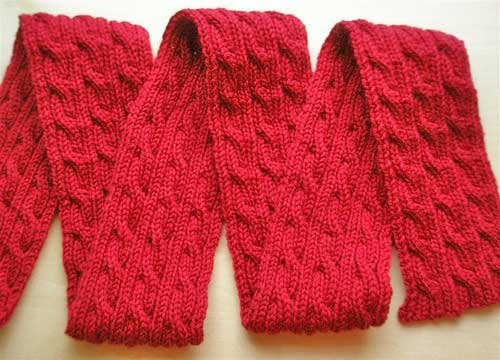
Braids are one of the simplest patterns, which also looks spectacular. A specific description of the pattern can be found in the annotation to the product itself, but the essence is always to make crosses of knitting, due to which the “braid” pattern is formed. The scarf will look most interesting if it is accompanied by a hat with a similar image.
Scarf in brioche technique
The basis of the product technique is English elastic, the pattern is formed from 2 different colors. It is double-sided, that is, the image is identical, but on one side one color prevails, on the other - the other. The peculiarity of the image is the creation of fancy curls. The lines twist, which occurs due to the decrease and addition of loops in the rows, the volume - due to yarns.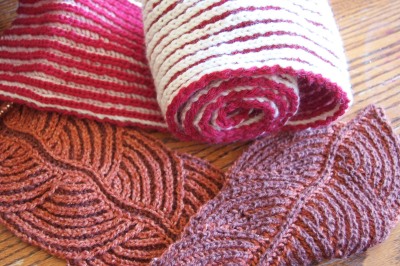
The specific pattern obtained in the work depends on the order of formation of elements in a row. It is necessary to master the basics of working with double-sided knitting. Odd rows are made with 1 color, even ones - 2. The beginning is a two-color elastic band. To obtain it, an odd number of loops is collected. 1 row - 1 loop is removed, the second - with a yarn over, then - the front one behind the front wall.
The last st in the row is knit behind the back wall. Row 2 – loops are made according to the pattern, color No. 2. Edge loops on both sides are removed. Purl st is knitted with an additional thread, the next one is removed. 3rd sequence – edge sts are knitted as in row 1. Then the loop with the yarn over is removed, the next one is knitted purlwise.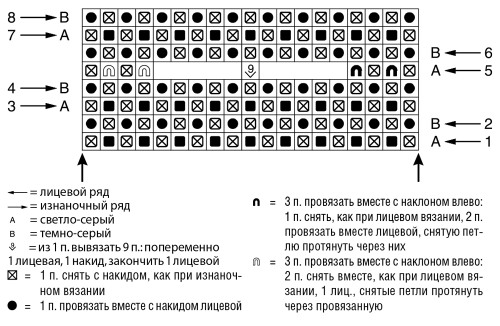
Row 4 – the front element with the extra thread is knitted together, then the st is transferred with the extra element to the second knitting needle. 1-4 columns are repeated in any quantity, then the main pattern follows in the chosen manner according to the drawing or diagram.
Openwork scarf with knitting needles
Such delicate and gentle items as an openwork scarf are often made with a crochet hook. But there are also knitting options. They can be made in one style, composed of several ornaments or consist of fragments. For options 2 and 3, considerable experience and imagination are required, since it is difficult to find ready-made patterns for combined items.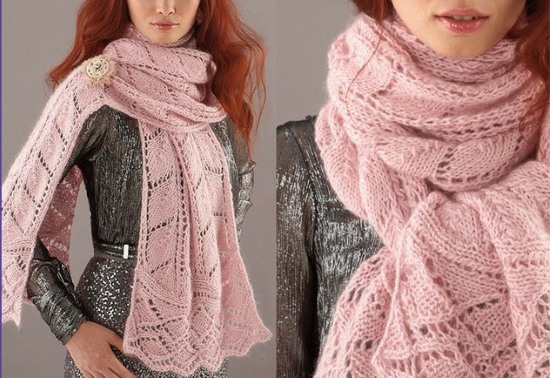
The disadvantage of the openwork ornament is that the technique is one-sided, and when the back side is exposed, protruding threads are shown, hiding all the beauty. Many experienced craftswomen prefer to knit with such threads as mohair, thin wool, cotton or angora.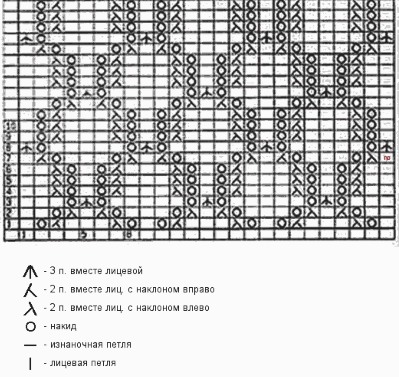
The best option is to create a product in the “cobweb” style.
It forms freely hanging loops with periodic curls, and the manufacturing scheme is simple. To get the desired effect, not only a thin thread should be used, but also a large diameter of knitting needles: 6-7.
Tube scarf
This product is universal. It can be used in both sports and classic styles. This scarf is put on over the head, but usually does not fit tightly to the neck. The straight shape allows you to cover the chin and neck. If the length and width of the fabric allows, it can be put on the head or lowered like a shawl on the shoulders.
The product made with large knitting looks more interesting. Therefore, it is better to use a voluminous woolen thread for work. If you want to give it an aesthetic appeal, then the threads should be thinner. A synonym for this scarf is also a collar.
Scarf-collar
The product is long, which allows it to be placed on the chest in folds, covering the neck and décolleté. It got its name due to the fact that the snood can be twisted and given volume. The peculiarity of the tube and collar is that such a scarf has no ends. During the knitting process, the ends are connected with a knitted seam or connected with a hook, and the product becomes one piece.
Knitted scarf made of hexagons
This product consists of individual elements that are then connected together. The work is done on double pointed needles. To obtain one piece, work begins on 3 knitting needles with 2 elements on each, from the 3rd row, the addition of loops begins with each purl element, up to a total of 12 sts. The next row must be knitted with knit stitches, while the yarn overs are made with a crossed loop.
On the 7th row, the work is transferred to 7 mm diameter knitting needles, you need 6 knitting needles with 2 sts on each. In this sequence, 1 yarn over is added to each loop. You get 24 elements. Every 4th row, an increase of 12 sts is formed 8 more times up to the 39th row, then a transition to another yarn color occurs. The 40th sequence is the last one.
Each round, starting with the 11th sequence where an increase is required, the gap between the loops with a yarn over gradually increases. The row is formed as follows: purl, 1 additional element, 3 purl, - 1 increase. The next time when it is necessary to form yarn overs, the gap will be 5, 7, 9 loops, etc.
So you need to knit 10 figures and sew them together.
Scarf with zigzag pattern
To obtain such a scarf, it is necessary to cast on 58 loops, the rapport is 14 elements, therefore the number of the initial row should be a multiple of this number + 2. The pattern is knitted in 1 row, all the second columns are made up of purl loops. A zigzag is obtained if 1 loop is removed, then 1 crossed front loop, formed from a horizontal loop pull-through, 3 front loops, 2 elements with a left cross.
Then 14 elements are repeated as a rapport: 2 knit stitches, so that they lean to the right, 3, 1 crossed from the yarn over, 2, 1 twisted, 3, 2 with a turn to the left, all knit. The rows alternate with each other up to a length of 170 cm.
Scarf-hood with braids
This product has long ends and a corner, which is designed to be put on the head. Due to its structure, the bonnet covers the head, ears, neck. This can be one of the varieties of snood. The work uses 2 pattern schemes, begins with 44 loops. 2 rows are made garter stitch, then the transition to 1 scheme occurs.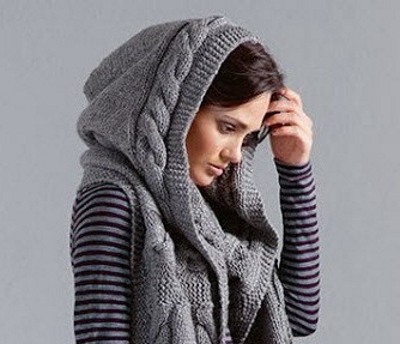
It is performed until the length of the product is 105 cm, then the loops are closed. This is the main fabric of the scarf.
For the hood, from the center of the scarf, you need to measure 21 cm in both directions, pick up loops along the edge and knit with pattern 2. After 21 cm of knitting, continue working in parts. You need to start forming the bevel of the part, for which on the right side on the left side of knitting, each 2nd sequence needs to be closed 5 times by 1 loop. The second half is symmetrical, after shaping, you need to sew both halves of the hood.
Knitted voluminous scarf
Such work can be done with any pattern. To obtain volume, several conditions must be met: thick yarn, large knitting needles. An additional effect is created by the corresponding pattern. This can be an elastic band, a relief pattern with braids, arans or another similar one. A voluminous scarf or snood can be obtained if you knit a product 160-200 cm long.
Scandinavian scarf
The peculiarity of this product is that it is laid in waves. To do this, you need to knit with shortened rows. To implement this in practice, you need to divide the collected loops into several parts, mark them with 6 markers. The beginning of the work is 42 sts, the markers are placed at the beginning, after 7, 15, 27, 35 loops and after all.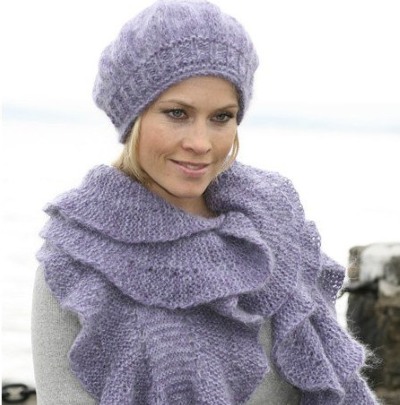
The first row is done entirely with the chosen pattern, then the work is turned around, 2-3 rows are worked up to the 5th mark, turned around and knitted to the end. The next 2 sequences are done up to the 4th marker, then similarly in the course of knitting. Then again alternate 2 rows up to the 5th and 4th markers. Sequences 10-11 are done completely, 1-6 marks.
Then you need to repeat the shortening of the rows to 5-4 markers 2 times, that is, continue like this for 8 rows, and again return to work to the 6th barrier. 21-22 sequence work goes to the 2nd mark, when turning - to the 1st, 23-24 column is knitted on the 3rd marker, returning to the beginning.
The next 4 rows repeat the last 2 sequences of actions. Sequences 29-30 return to knitting 1-6 markers. The next 8 rows are similar to 21-28.
Hat-scarf
This variant differs from the previous one in that in such a product the front part of the product is knitted in the forehead area. The result is a hat, the ends of which turn into a scarf.
Cape-scarf
Variants of such a product are a shawl, stole or gorget. Its peculiarity is its large width, allowing you to wrap the fabric around your shoulders. This not only warms you up in chilly weather, but also complements your look. The more complex the pattern, the more beautiful the product will look.
Knitting a scarf with knitting needles according to a pattern simplifies the task, because you can visually see how the element will look if it is implemented as required in the annotation.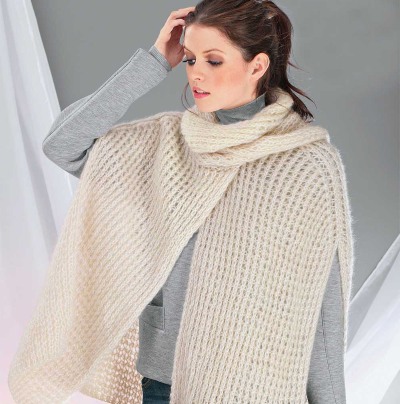
For one of the product variants with a transverse pattern, alternating braids and diagonal interlacing of stripes, you will need 700 g of wool yarn and straight knitting needles 5.5 mm. To obtain the product, a set of 102 elements begins with a garter stitch of 55 cm. The width should be 45 cm, if the value is not enough, then you need to add loops at this stage.
Then comes 85 cm of the main pattern, continues with an elastic band for another 30 cm and ends with a garter stitch of 25 cm. To obtain a hole through which the second end of the product is threaded, 102 loops are cast on the knitting needles, the work is an elastic band of 30 cm, which is sewn to the main part of the fabric upon completion.
Circular scarf "Cloud"
This product got its name due to the fact that it is made from light, airy, but warm yarn..
The "cloud" is best suited for openwork knitting. This is a scarf that can be wrapped in several turns or worn long. The work is done with 3.5 mm circular knitting needles, you will need 50 g of thin yarn. To obtain a 100 cm product, 220 elements are collected on the tool.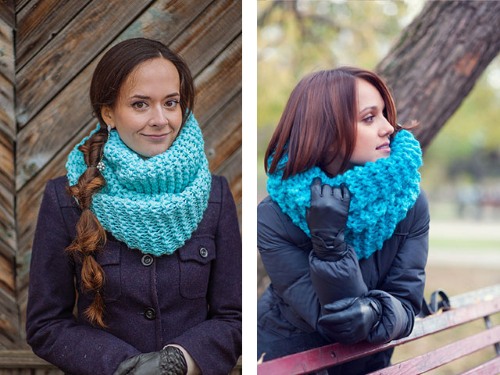
To make it easier to recognize the beginning of a row, an identification element is placed. The first 2 rows are purl stitch. Then a pattern is implemented, which implies 12 rows of the product. The pattern must be repeated 5 times. In the 67th row, all elements must be done with face loops, and in the next one - with purl loops, repeat in the same order another 4 columns and close all loops.
Patterns for scarves
Almost all patterns that can be used to knit a sweater, hat or other item of clothing are applicable to this item of clothing.
The most common options are the following:
- rubber;
- garter stitch;
- pearl;
- braids;
- arans;
- openwork version;
- front and back stitch.
A simple rib pattern, it would seem, cannot bring anything interesting to knitting. In fact, there are several dozen variations of the pattern.
Swedish elastic
You can knit a scarf with Swedish rib knitting needles. This will make it different from the usual patterns.
The classic pattern is an alternation of front and back loops, due to which the finished product is stretched in the longitudinal and transverse directions. Therefore, the initial number of loops must be even. The Swedish version is distinguished by the fact that the tool has an odd number of loops, and the fabric shifts from row to row.
Polish gum
It is distinguished by the fact that the edge of the front loop protrudes significantly, compared to other types. 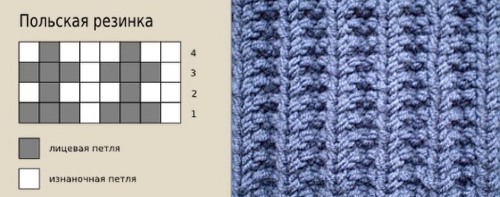 Polish ribbing is often the basis of many products. It is distinguished by the fact that in odd rows there is an alternation of 2/2, and in even rows it begins with a purl stitch and ends with 1 front element.
Polish ribbing is often the basis of many products. It is distinguished by the fact that in odd rows there is an alternation of 2/2, and in even rows it begins with a purl stitch and ends with 1 front element.
Turkish elastic
In this type of knitting, the rows are diagonal. To prepare the fabric, you need to knit the first sequence with purl stitches, and the second with knit stitches. The edge loops are removed without being knitted. Then the main row begins.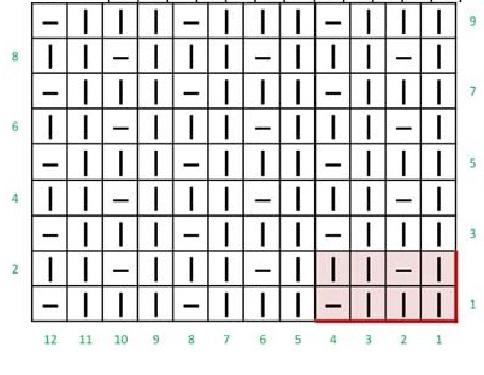
Edge, purl, then repeat the sequence where 2 purl sts are knitted together, and then a yarn over is formed, to the end of the column. Next row: 1 is removed, knit st, repeat the yarn over combination, 2 together knit sts, penultimate knit st, edge st.
French elastic
Refers to one-sided types of fabric, it is better to knit on straight tools. The pattern is visible only on light yarn.  Consists of an initial set, a multiple of 4, +2 elements. The first row begins with a kr.p, then 2 purl. loops along the edges and 2 k.p in the middle.
Consists of an initial set, a multiple of 4, +2 elements. The first row begins with a kr.p, then 2 purl. loops along the edges and 2 k.p in the middle.
Bulgarian gum
This variant is interesting because it combines purl loops and crossed knit loops. This movement of elements allows you to get an openwork braid in place of the knit loops. Many call this type of elastic similar to the English variant. The only difference is that the sequence of different types of loops is 4:2. The initial set should be a multiple of 6 + 2 kr.p.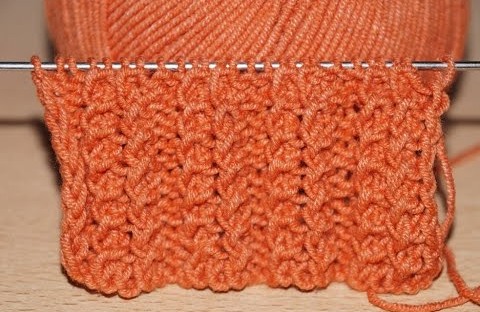
In the first row, you need to knit 4 knit stitches and 2 purl stitches. The next sequence is done with the front stitch: 2 stitches, then a yarn over, 2 stitches are removed inside the additional element (repeated 2 times). Alternating these 2 rows allows you to get horizontal crossbars from yarn overs, through which the front stitches are passed.
American rubber band
This is a complex type of knitting, problems with the formation of the yarn over may arise. The number of loops must be divisible by 3, +2 edge loops. 1 row consists of 2 front elements and 1 out. The second row - the outer loops are removed. To make it possible to correctly perform the element, the yarn over is performed on itself, loops knitted with front loops are pulled through it.
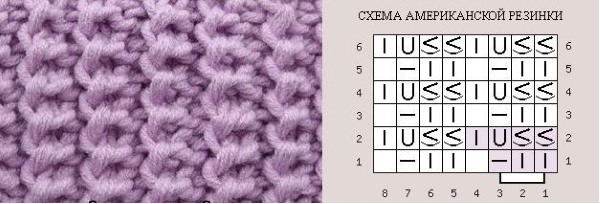
The sequence consists of 1 l.p, nak., 2 l.p., stretched through a new auxiliary st.
False English elastic
In this pattern, the elements are performed asymmetrically. In the 1st row, the ratio of front and back loops is 3:1. In the second row, there are l.p.-i.p.-l.p. 2:1:1.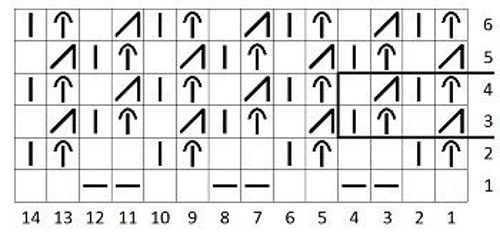
In appearance, this pattern is no different from a simple English elastic band, but in execution it is very significant.
Two-color English elastic
This pattern is the basis of the brioche pattern. Two colors in the pattern can be combined in horizontal or vertical rows. The horizontal version involves changing colors every 2 rows. This results in a contrasting stripe.
The principle of vertical two-color elastic is described in the brioche technique. The result is that the front elements are made in one color, and the back elements between them are made in another color.
Faceted rubber band
It is called so because there is a shift of 1 loop, and the row seems to “walk” back and forth. 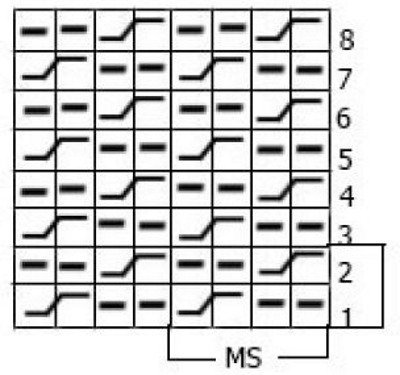 The first row consists of 1 knit, 1 purl, repeat 3 knits - 1 purl, the last one is knit. At the beginning of the second sequence 3 purl, alternation 1 knit - 3 purl.
The first row consists of 1 knit, 1 purl, repeat 3 knits - 1 purl, the last one is knit. At the beginning of the second sequence 3 purl, alternation 1 knit - 3 purl.
Rubber band cartridge belt
In appearance, this is a classic elastic band, and in execution - a pressed volumetric pattern. In the first row, it is necessary to remove the outer element, then 3 l.p., remove the next one without knitting, the thread remains in front of knitting. In the second row, after the outer one, a face p. is formed and the combination of a removed loop is repeated (in a similar way), 3 l.p.
If done correctly, the last elements in the first row are 4, and in the second row - 2 front ones.
Beaded elastic band
This variation requires a set of stitches in multiples of 5, with an additional 4 elements, 2 for symmetry and 2 outer ones. In the first row, the rapport is 1 p.s., 1 k.s., 1 p.s., 2 k.s. It consists of 2 knit elements and a rapport. 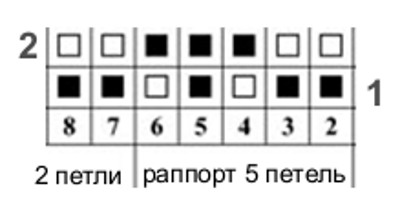 In the second row, the repeating sequence consists of a ratio of knit stitches to purl stitches of 3:2. The second sequence combines 2 purl stitches and a repeat pattern to the end.
In the second row, the repeating sequence consists of a ratio of knit stitches to purl stitches of 3:2. The second sequence combines 2 purl stitches and a repeat pattern to the end.
"Anchor chain"
Knitting a scarf with knitting needles using the “Anchor Chain” pattern allows you to create a product that resembles the connection of loops of a sea vessel’s chain. 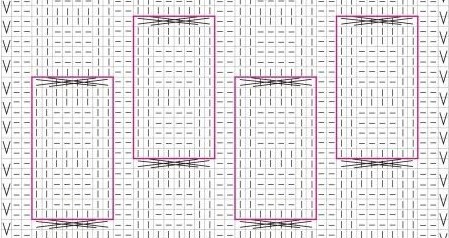 To obtain the product, you need to cast on 44 loops using tool #3. The beginning of the scarf is a 1:1 elastic band 4 cm, then a pattern according to the scheme. The fabric ends at a total length of 160 cm. The last 3.5 cm should also be made with an elastic band.
To obtain the product, you need to cast on 44 loops using tool #3. The beginning of the scarf is a 1:1 elastic band 4 cm, then a pattern according to the scheme. The fabric ends at a total length of 160 cm. The last 3.5 cm should also be made with an elastic band.
"Waves"
The popular "wave" pattern is a geometric universal image and allows you to knit a scarf of any size and for any family member. It can also be called relief and fantasy. This pattern is combined with other types of knitting, for example, with garter or satin stitch. The wave can be made in horizontal and vertical directions.
To obtain it, loops are decreased and increased in rows one above the other.
An example of a simple wave is a relief pattern, which uses only knit and purl elements. The initial row consists of loops divisible by 6, with the addition of 2 outer ones. 1 element is removed, the last one is always purl. The first loops are purl, after them come knits.
The first row - 3 elements of each type, starting with the purl, the second - according to the pattern, the 3rd - 2-3-1, the 5th - 1-3-2. In the 7th sequence, 3 front loops are knitted, after them 3 purl, the 9th repeats the 5th column, and the 11th - 3. After the 12th column, there is a return to the 1st row and a repeat to the desired length of the product.
"Hedgehog"
The "hedgehog" pattern is also called knots or scales. The loops hang in even rows on the outside, forming a semblance of scales. When forming rows, the pattern will be formed on the back side. The initial row is an even number of loops. The 1st sequence is formed from alternating front and back elements. The second is knit stitch with a yarn over, purl stitch.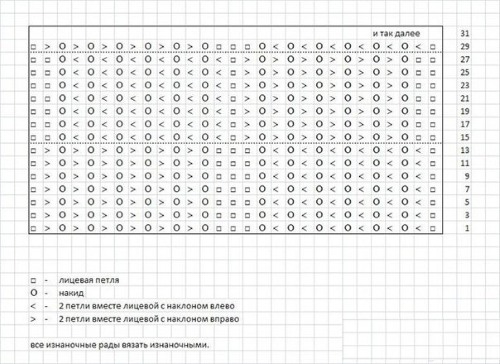
Third row - the front loop with a yarn over obtained in the previous column is removed, another additional element is thrown on. The last sequence of the pattern - the element with new loops is knitted as a front loop, the second - out. Then rows 1-4 alternate
"Asters"
This pattern is complex, requires skills and a competent scheme for execution. In appearance, it resembles the flowering of a plant from this family. Starting to knit a scarf with knitting needles according to this scheme, you need to have the skills of working with removed loops and knitting several elements from one. Beginner needlewomen need to be guided by the description of the scheme.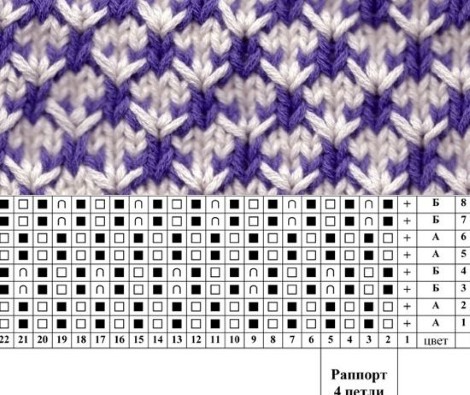
Creating original clothing accessories with your own hands allows you to not only receive admiring glances from passers-by, but also learn to realize your own desires, create new favorite things for yourself and your loved ones.
Video: scarf with knitting needles with description, diagrams
The original pattern for a scarf with knitting needles, see in the video:
How to knit an openwork scarf with knitting needles, watch the video:

Thank you for the useful and interesting article!
One of the simplest knitted items that even beginners can do is a scarf.